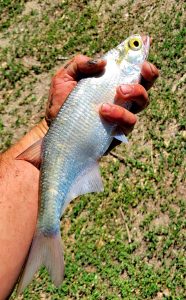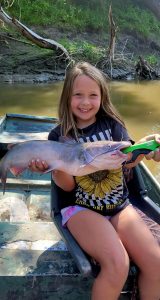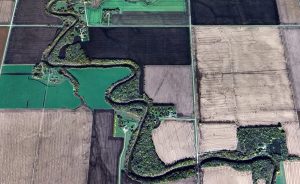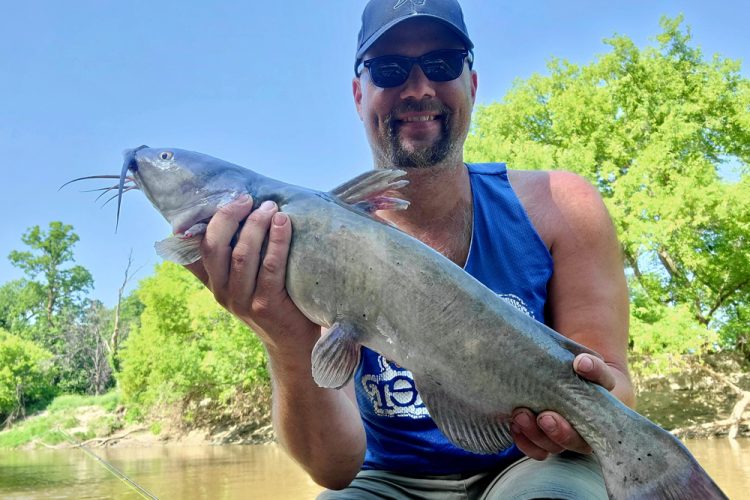Author Jeffrey Miller with a solid Sheyenne River catfish. The fish was
caught on a piece of cut goldeye during the middle of the day.
North Dakota’s Other Rivers
By Jeffrey Miller
It’s no secret that the Red River of the North, comprising most of the border between Minnesota and North Dakota and flowing in Manitoba, offers world-class fishing for channel catfish. I’ve enjoyed many days on the water there, mostly with guide Brad Durick, and have boated cats well into the 20-pound range. However, there are also rivers in North Dakota that offer fast catfish action with little to no pressure.
Sheyenne River
My home is on the banks of the Sheyenne River, and I have fished it extensively for the last six years. A major tributary of the Red River, the Sheyenne flows for 591 miles through eastern North Dakota. There are numerous dams on the river, the largest being Baldhill Dam, which backs up Lake Ashtabula, a 27-mile-long reservoir.

Channel catfish abound in the Sheyenne, especially as it flows closer to the Red. In my experience, the fish tend to be migratory, seeking out deep holes in the winter before spreading out after the nearly every year spring flooding. My buddy Matt Shappell caught a tagged channel on the Sheyenne, 15 miles from its terminus into the Red. The 32-inch fish had been tagged in Manitoba!
Access to the Sheyenne can be difficult, as most of the land adjacent to it is privately owned. In North Dakota, if land is not posted to prevent access, it is legal to traverse private land. However, it’s always good practice to ask landowners for access. It would be very rare to be turned down for fishing access. The Sheyenne National Grasslands, over 70,000 acres of publicly owned land, offers access to the river. Be prepared, however, to hike. The diverse landscape does not provide easy access to the water, and you’ll earn the cats you catch.
In the lower reaches of the Sheyenne, catfish tend to run nearly as large as the in the Red. I consider any cat over 12 to be a trophy and have only caught two that have exceeded 15 pounds. Though the Sheyenne is rather small, the current is swift. A tussle with a 15-pound fish, in the current with a small boat, is something an angler will never forget!
Wild Rice River
The Wild Rice River is a small tributary of the Red River, 251 miles long contained in the southeastern part of the state. It’s much smaller than the Sheyenne River, with an average flow rate of only 100 cubic feet per second. An angler with a decent arm can easily toss a baseball across the river to the other side.
The Wild Rice River flows into the Red at a nature park south of Fargo, allowing boats to fish both the Red and the Wild Rice. Because of the smaller size, the top end fish tend to be smaller. A 10-pound Wild Rice channel should be considered a trophy. An angler looking for eater fish, however, would have a tough time finding a better location than the Wild Rice.

James River
The James River of central North Dakota, a tributary of the Missouri River, is nearly 710 miles long. In North Dakota, the river is rather small, gaining size and depth as it flows into South Dakota. The “Jim,” as locals call it, is more often the target of walleye anglers. But just like the Sheyenne and Wild Rice, once the water warms, the catfishing turns on.
Fishing the Other Rivers
While I have caught plenty of fish from the shore, these days I spend most of my time in a boat. Kayaks are a good option for a single fisherman, but I’ve never gotten very comfortable fishing from one. Instead, I use a small 10-foot johnboat. Equipped with a 40-pound-thrust trolling motor and a Cat River anchor, I can fish all day in comfort.
Springtime flows can be excessively dangerous, so plan to wait for the river to return to its banks. While there are fish to be caught in the early part of the summer, I seem to catch most fish, especially trophy size, during the heat of summer—the middle of July through the early part of September.
With numerous bends and turns in the smaller rivers, the deep holes tend to hold the most fish. Don’t overlook debris piles, though. Big fish will sit in the brush and snap up food as it drifts by.
North Dakota allows two lines per angler, so when I’m fishing alone, I will have one line baited with dipbait and the other with cut-bait. Goldeyes are common in the river and will usually surface near dark each evening. With an ultralight rod and a tiny surface popper, an angler can catch enough bait for the entire summer when the bite is hot.

Goldeyes are very soft fleshed fish, so I prefer to freeze them before using them as bait. Hacking off a small piece and attaching it to the hook when it’s frozen allows it to melt in the water and leave a scent trail.
Dipbaits work great for cats on the Sheyenne. Not only can an angler catch a limit of eaters but there is always the chance for a trophy. I’ve caught more fish over 10-pounds on dipbaits than anything else.
Rods in the medium-heavy class and reels spooled with 15-pound-test monofilament comprise my preferred tackle. Line that’s too heavy ruins the fight of the fish, and much lighter makes it hard to steer them away from snags. Circle hooks alleviate the problem of deep hooking, especially with small fish, and surgical tubing holds plenty of sticky dipbaits. Gear for small river catfish is simple and inexpensive.
North Dakota’s Other Rivers
There is no doubt the Red River is the destination for channel catfish anglers. Don’t overlook the other rivers, though. Consider an extra day in the state if you are traveling to fish the Red. A do-it-yourself day on the water of a small river may be the best fishing an angler ever experiences!
(Jeffrey Miller is a freelance outdoor writer who has been published in over 20 magazines and newspapers. He writes about topics as diverse as hunting, fishing, fur trapping, gardening and modern homesteading. He is the author of three books.)



